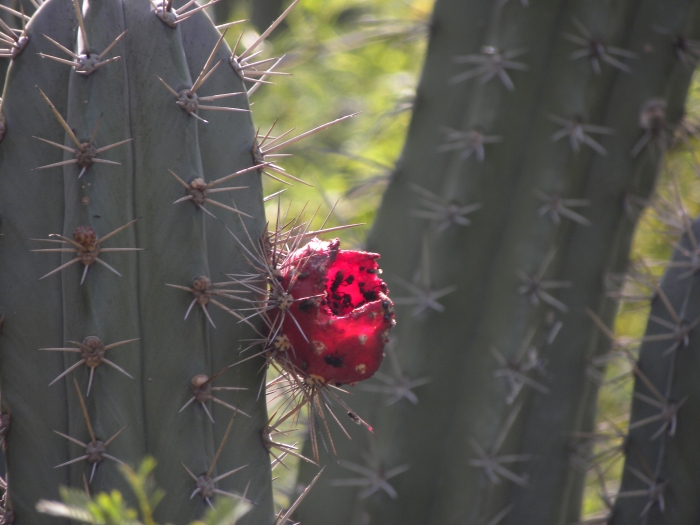Mexican Organ Pipe Cactus
(Stenocereus griseus)
Mexican Organ Pipe Cactus (Stenocereus griseus)
/
/

Steven Bodzin
CC BY 4.0
Image By:
Steven Bodzin
Recorded By:
Copyright:
CC BY 4.0
Copyright Notice:
Photo by: Steven Bodzin | License Type: CC BY 4.0 | License URL: http://creativecommons.org/licenses/by/4.0/ | Rights Holder: Steven Bodzin | Publisher: iNaturalist | Date Created: 2009-08-30T12:16:44-07:00 |

























Estimated Native Range
Summary
Stenocereus griseus, commonly known as Mexican organ pipe cactus, is a tree-like cactus native to arid and semi-arid regions, including the deserts and dry forests of Mexico, coastal Venezuela, and the Guajira Peninsula of Colombia. It can reach up to 30 feet in height with columnar stems that are typically up to 5 inches in diameter, forming a candelabra-like structure. The stems are ribbed, with spines arranged along the ribs. This cactus blooms at night with large, white, funnel-shaped flowers that are pollinated by bats and moths, making it an essential part of the desert ecosystem. The flowering season is mainly in the spring and summer, and the flowers are followed by edible fruits that vary in color from white to yellow, red, and purple.
The Mexican organ pipe cactus is valued for its striking architectural form and is often used as an ornamental plant in xeriscapes and desert gardens. It is also commonly employed as a living fence in its native range due to its size and spiny stems. In cultivation, it requires full sun, well-draining soil, and minimal water once established, reflecting its adaptation to desert conditions. While it is drought-tolerant, it is sensitive to frost and needs protection in cooler climates. It has no significant disease problems, but overwatering can lead to root rot.CC BY-SA 4.0
The Mexican organ pipe cactus is valued for its striking architectural form and is often used as an ornamental plant in xeriscapes and desert gardens. It is also commonly employed as a living fence in its native range due to its size and spiny stems. In cultivation, it requires full sun, well-draining soil, and minimal water once established, reflecting its adaptation to desert conditions. While it is drought-tolerant, it is sensitive to frost and needs protection in cooler climates. It has no significant disease problems, but overwatering can lead to root rot.CC BY-SA 4.0
Plant Description
- Plant Type: Succulent
- Height: 4-30 feet
- Width: 2-8 feet
- Growth Rate: Slow
- Flower Color: White
- Flowering Season: Summer, Fall
- Leaf Retention: Evergreen
Growth Requirements
- Sun: Full Sun
- Water: Low, Medium
- Drainage: Fast, Medium
Common Uses
Border Plant, Drought Tolerant, Fire Resistant, Low Maintenance, Rock Garden, Street Planting
Natural Habitat
Arid and semi-arid regions, including deserts and dry forests
Other Names
Common Names: Organ Pipe Cactus, Grey Cereus, Tall Candelabra Cactus, Cadushi, Dader, Datu, Kadushi, Pitayo of Cuba
Scientific Names: , Stenocereus griseus, Cactus eburneus, Cactus eburneus, Cereus clavatus, Cereus deficiens, Cereus eburneus, Cereus eburneus var. clavatus, Cereus eburneus var. monstrosus, Cereus eburneus var. monstrosus
GBIF Accepted Name: